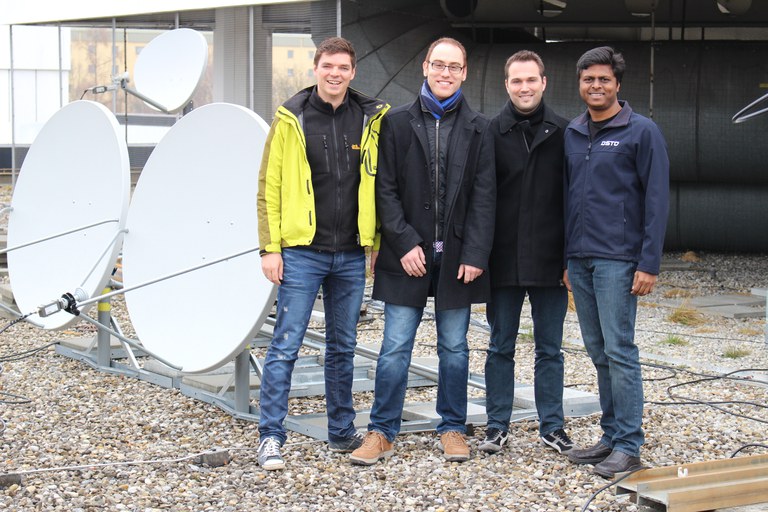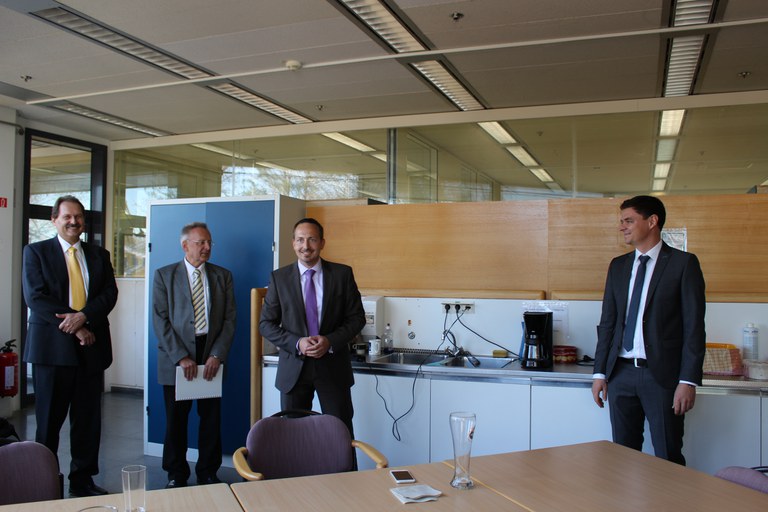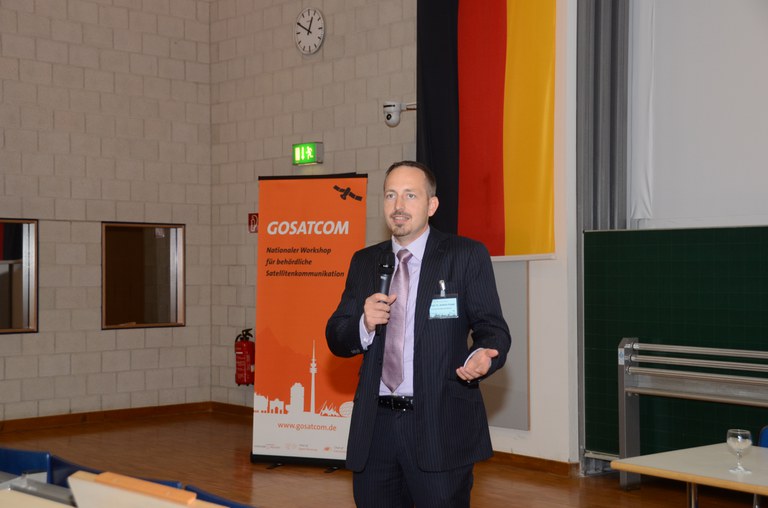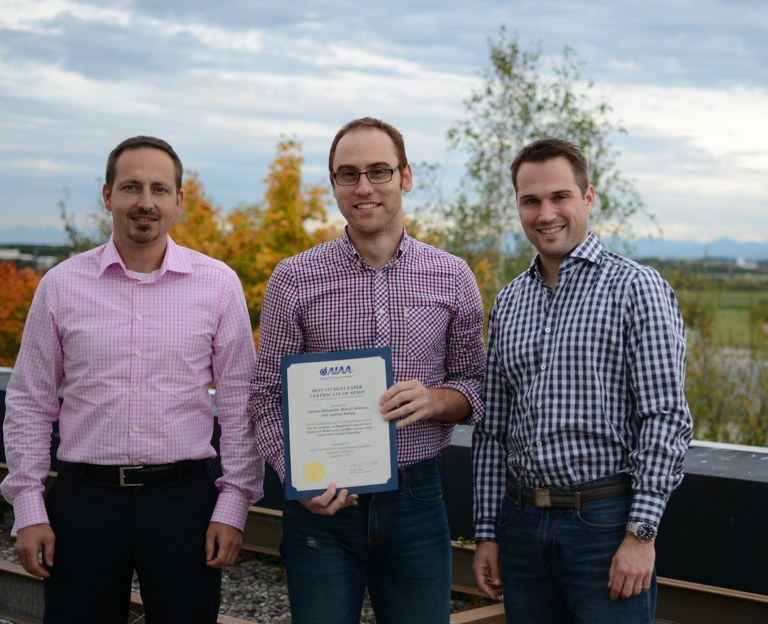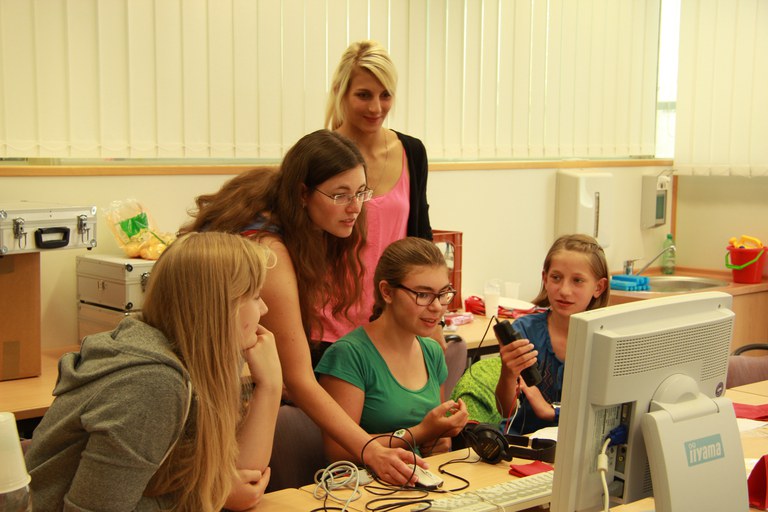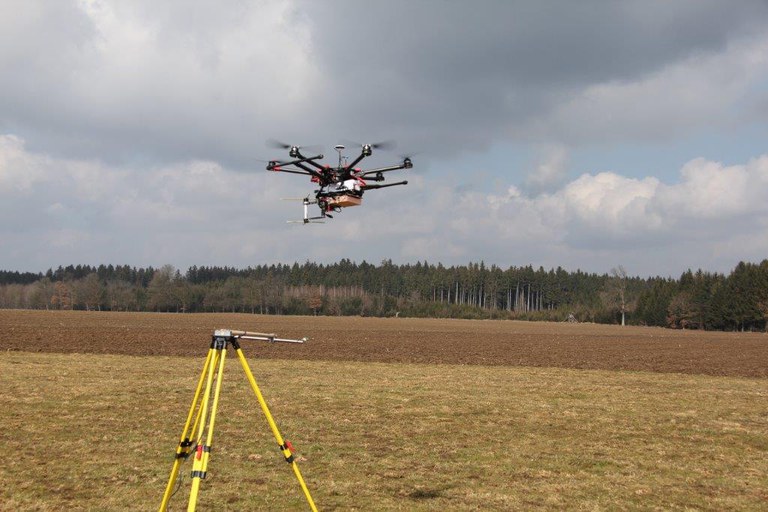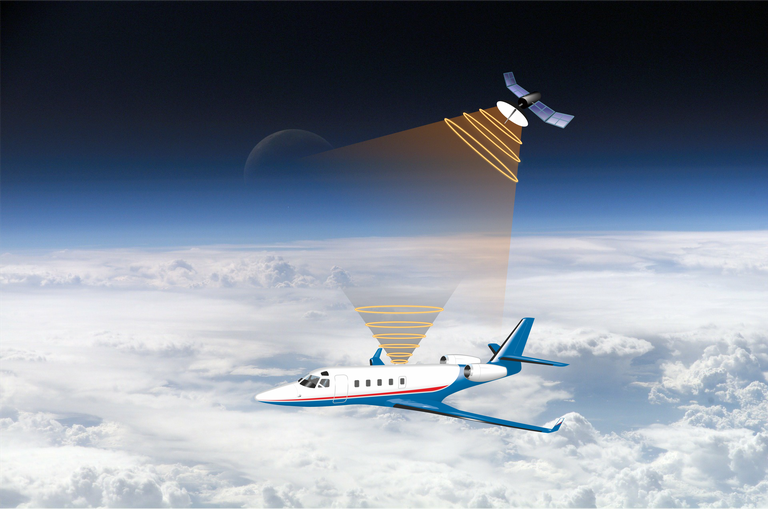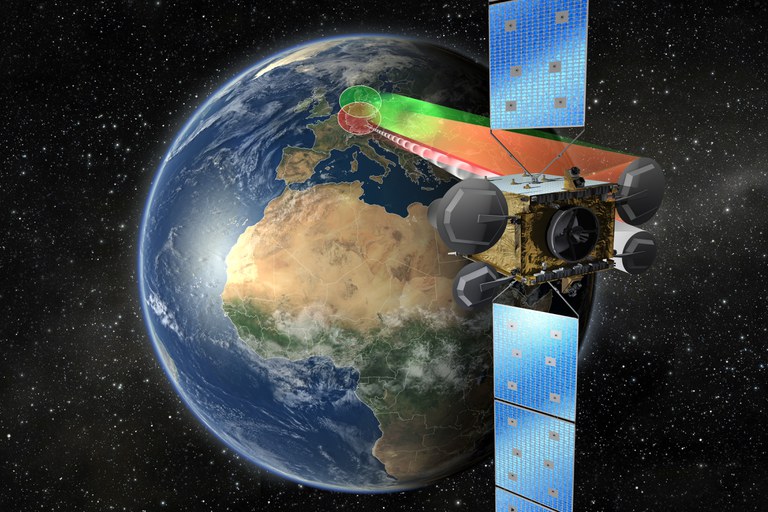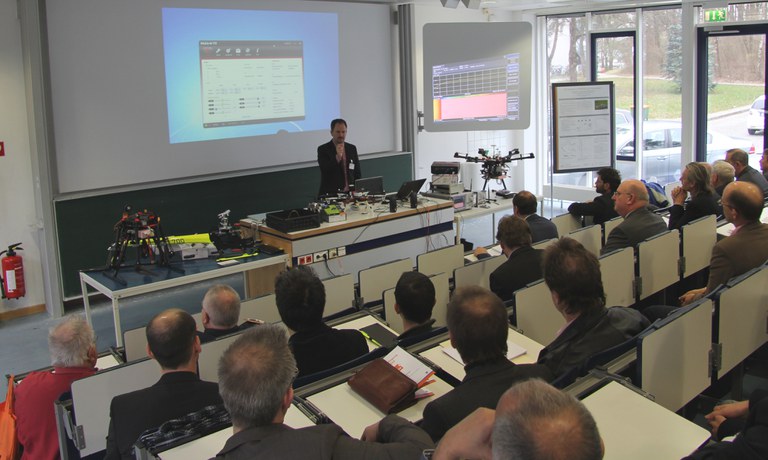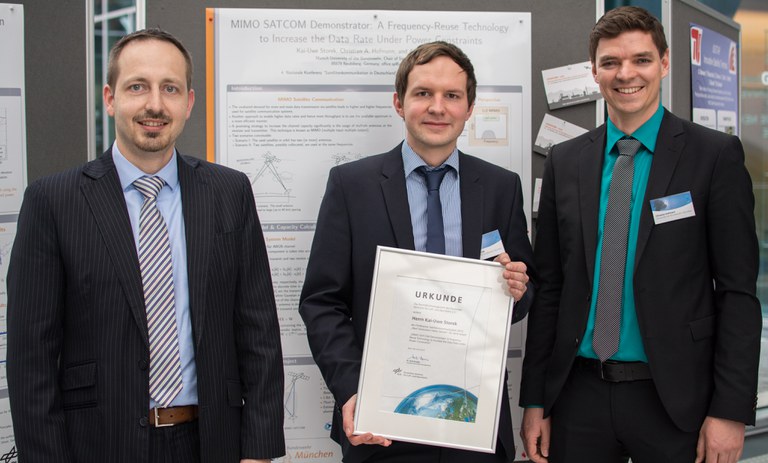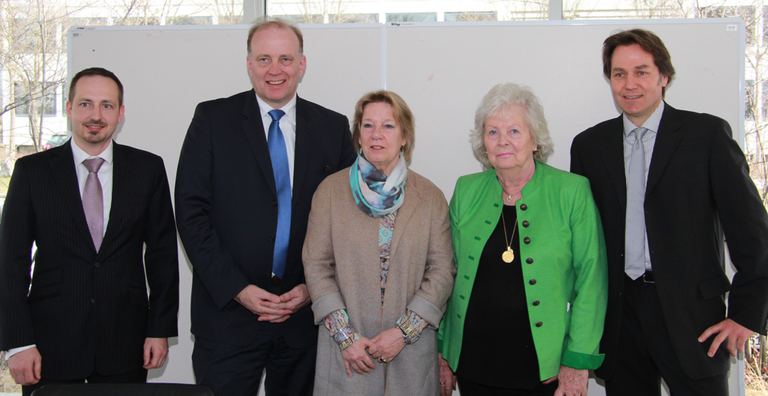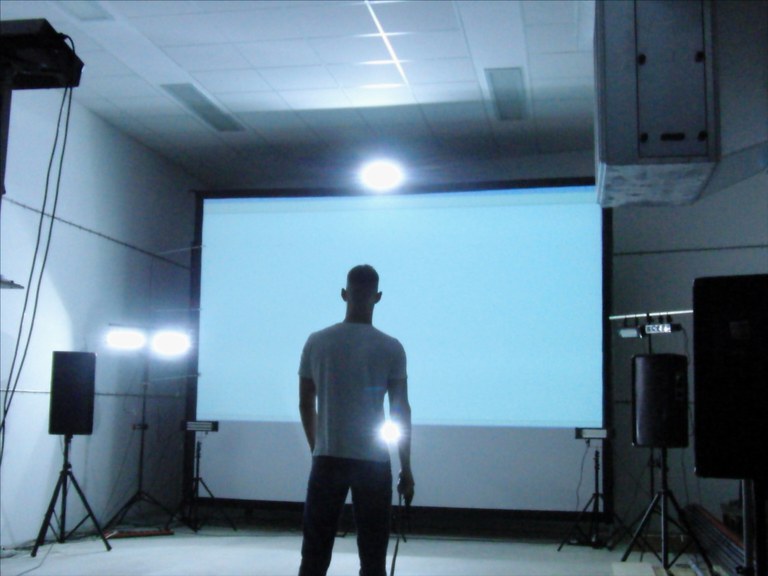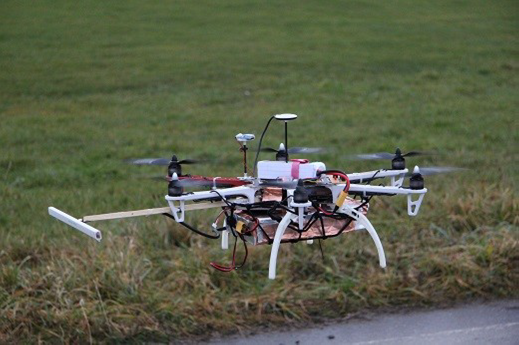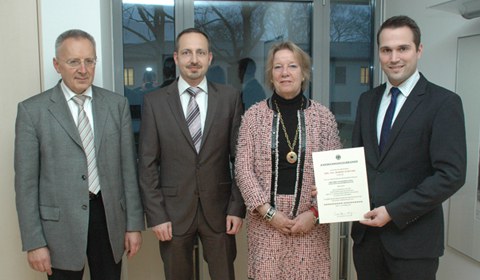| newer News / older News |
Scientific Exchange between Australia and Germany December 1, 2015: The Chair of Signal Processing (CSP) has started successfully a scientific cooperation with the University of South Australia (UniSA), Adelaide. In this context Mr. Balachander Ramamurthy, a researcher at UniSA and employee of the Australian Defence Science and Technology Organization (DSTO), has recently finished a four weeks research stay at the Chair of Signal Processing. The objective has been the common work on the broad field of Multiple-Input Multiple-Output (MIMO) and its application to satellite communications, one of the major research topic of our chair. During Balachander’s stay in Munich, he has been an active part of the MIMO SATCOM research team at CSP and has been involved in a test and measurement campaign using two geostationary satellites of Eutelsat S.A. Since the CSP is among the leading research institutions in the field of MIMO, having built a unique MIMO SATCOM testbed over the recent years here at UniBwM, these kinds of measurements are possible only at our institute. Therefore, UniSA was keen to establish this scientific exchange program and travel around the globe to use the setup. Motivated by his PhD topic MIMO over satellite, Balachander’s main achievement has been to theoretically derive, implement and test an enhanced measurement strategy enabling passive MIMO channel measurements and capacity analyses for a greater variety of satellites. First results look very promising and are going to be analyzed within the next weeks. We would like to thank Balachander for his great work and his excellent contributions!
|
Dr.-Ing. degree awarded to Christian Hofmann November 3, 2015: The “Dr.-Ing.” Degree has been conferred to Christian Hofmann for his thesis entitled “Measurement and Modeling of the MIMO Channel with a Focus on Line-of-Sight”. Giving a very vivid and comprehensive lecture on his contributions, Dr. Hofmann has finalized a 5-years intense work on the modelling of wave propagation for next generation cellular networks. His basic achievements comprise a novel channel model which for the first time correctly predicts the MIMO channel capacity as well as all other important channel parameters, but is superior over existing modeling approaches in terms of implementation complexity and required calibration data sets. The jury has been impressed by the broad scope of Dr. Hofmann’s very good work, ranging from the design and implementation of a fast MIMO channel sounder over extensive measurement campaigns to complex modeling & simulation strategies. Members of the jury have been: Prof. Knopp (UniBw, chairman), Prof. Lankl (UniBw, 1. Examiner), Prof. Czylwik (University of Duisburg-Essen, 2. Examiner). Congratulations to Dr. Hofmann!
|
GOSATCOM - 2015 October 12-14, 2015: The Institute of Information Technology, Chair of Signal Processing of the Universität der Bundeswehr München (UniBwM) hosted successfully the first workshop on governmental satellite communications (GOSATCOM). GOSATCOM is a new networking and discussion forum bringing together industry, governmental institutions and academia, and was held from 12th to 14th October. This three day event fosters the information exchange in all topics of governmental and military satellite communications (SATCOM) including the latest technology developments, applications and user experiences. Prof. Andreas Knopp, General Chair of GOSATCOM and Chair of Signal Processing, and Prof. Merith Niehuss, president of the Universität der Bundeswehr München, were proud to welcome over 120 participants from all stakeholders of governmental and military SATCOM in the main auditorium (Audimax) of the UniBwM.
GOSATCOM attracted 40 submissions, from which 30 have been selected by the program committee. The keynote speeches from Colonel Wilfried Haverkamp, Betriebszentrum IT-System der Bundeswehr, and Prof. Dr. Arne Jacob, Technische Universität Hamburg-Harburg, summarized experiences and future challenges in military satellite communications, and the latest advances in circuit design for space applications, respectively. With contributions from the European Space Agency, the German Aerospace Center, Fraunhofer-Gesellschaft, the Federal Ministry of the Interior, and numerous industrial presentations, this new event underlines its claim to enhance the discussion and information exchange between the governmental, industrial and scientific communities. We would like to thank our organizing team, technical program committee, as well as all presenters, speakers and contributors for making this workshop a great success. Many thanks go also to our industrial sponsors, without whom this event would not have been possible. It was a pleasure meeting you all in Munich! We are looking forward to welcoming you again at GOSATCOM 2017. More information can be found here. (in German only) |
Best Student Paper Award September 8, 2015: Dipl.-Ing. Thomas Delamotte and Dipl.-Ing. Robert Schwarz, both research assistant for Prof. Dr.-Ing. Andreas Knopp, have been honored with the „Best Student Paper Award“ on the 8th of September 2015 at the „33rd AIAA International Communications Satellite Systems Conference“ in Gold Coast, Australia. The results presented by Thomas Delamotte, entitled „On the Accuracy of Simplified Volterra Series Models for Multicarrier Systems Using Faster-than-Nyquist Signaling“ deal with the mathematical modelling of nonlinear satellite transmission chains. The core of the matter is to point out which level of mathematical detail is required to accurately model such nonlinear chains. The proposed modeling represents a starting point for the design of new algorithms complying with the high data rate requirements of next generation “High-Throughput-Satellites”.
The „International Communications Satellite Systems Conference” of The American Institute of Aeronautics and Astronautics (AIAA) is the world´s most significant technical conference on satellite communications. |
Girls and Technology 2015 August 10-12, 2015: Summer school project “BIOSIGNALS - windows to our body” at the Chair of Signal Processing.
Can we make our thoughts visible? Can we hear our muscles working? Questions like these were addressed by teenage girls between 12 and 14 years who participated in the BIOSIGNALS project during summer holidays 2015. Assisted by staff members and students the participants enthusiastically mounted electrodes, turned their lunch into bioelectrical voltage generators, registered eye movements, and analyzed heart rates and reaction times. During the three project days the girls proactively experienced a variety of biomedical signal registration and analysis techniques which are used by physicians for clinical diagnosis and employed by scientists for basic research. Registration of cardiac activity (ECG), cerebral activity (EEG), or muscular activity (EMG) are well-known examples. Starting with a brief introduction into basic biological and technical facts, the girls conducted experiments and measurements by themselves, thus getting a tantalizing glimpse into the fascinating field of biomedical information technology. Questions like “Who is the fastest and most accurate fighter against her virtual opponent in the electronic fencing simulation” were examined at least as attentively as the mathematical and technical basics of computer tomography and magnetic resonance imaging technologies. More information can be found here. |
ICARUS channel measurements at ICC 2015 June 11, 2015: Robert Schwarz has presented first results about channel measurements for the ICARUS initiative, a global wildlife monitoring project led by Prof. Dr. Martin Wikelski, Director of the Max Planck Institute for Ornithology (www.icarusinitiative.org). The measurement data samples, which have been uniquely collected via the Bundeswehr’s geostationary UHF satellite, give first insight into the true multipath behavior of the propagation channel. These results will now be used for maturity checks of the current physical layer design of the animal tags. Although the satellite propagation channel has been believed to be already well described in literature, the measurements have proven that the ICARUS project opens a radically new field of radio applications which has not yet been covered by earlier measurements. Thus, the new measurement results aroused great interest within the community, resulting in vivid discussions with renowned experts like Barry G. Evans (editor of “International Journal of Satellite Communications and Networking”) or Giovanni Giambene.
|
|
Next Generation SATCOM for UAVs May 15, 2015: A contract has been concluded with Ottobrunn based IABG mbH on research on SATCOM terminals and satellite links for the next generation air based surveillance platforms.
|
SATCOM Mission Heinrich Hertz April 20, 2015: The Chair of Signal Processing participates in ECSS Phase C of the German National Scientific SATCOM Mission “Heinrich Hertz”. A research contract covering different aspects of a payload for secure SATCOM has been closed with the Bundeswehr’s procurement agency.
|
Workshop on “Countermeasures against drones” March 26, 2015: Due to the expertise in military communication data links including jamming and the usage of civil multicopters, the institute of information technology contributed to the annual conference of the CODE research center for Cyber Defense with a workshop on countermeasures against drones. Up to now there exist neither effective defensive actions, which could be taken to secure important people and areas, nor are there systems to detect incoming drones. During the well-attended workshop held by our institute, two demonstrations of a GPS spoofer and the jamming of the control datalink were shown which could be a possible solution after further research.
|
“Next Generation Meets SATCOM” Award March 25-26, 2015: The SATCOM research group receives the “2015 SATCOM Advancement Award of the German Space Agency (DLR)” for their poster “MIMO SATCOM Demonstrator: A Frequency Reuse Technology to Increase the Data Rate under Power Constraints”. The award has been handed over to Kai-Uwe Storek and Christian A. Hofmann by the DLR board member Dr. Gruppe at this year’s National Conference on Satellite Communications in Bonn. The winners have been selected by the audience in terms of novelty of their idea, practical usefulness / applicability, and quality of presentation. The award includes a financial incentive enabling the authors to present their results at a major international conferences on satellite communications.
|
Endowed Chair for Secure Space Communications March 24, 2015: OHB System AG, Europe’s third largest satellite manufacturer, endows a chair for Secure Space Communications to our institute. A six-years contract has been signed by the president of the Universität der Bundeswehr München, Prof. Merith Niehuss, and the CEO of OHB System AG, Marco R. Fuchs. The endowed chair is dedicated to the improvement of protected information transmission via satellite. In recognition of our institute’s outstanding expertise and technical capability, by request of the sponsor the new professor will be mentored by the chair or signal processing, Prof. Andreas Knopp. With the start of the regular appointment process within the next weeks, the new post will be assigned by early 2016.
More information can be found here. (in German only) |
Non-lethal weapons - Demonstration of our experiments in the MB ballistic lab to WTD 52 delegates March 5, 2015: Biomedical Information Technology includes the application of knowledge on the biomedical system (mostly described in abstract models based on System Theory) to develop tools of everyday life; i.e. designing a human machine interface for best cooperation and communication between both engaged parties (e.g., pictorial menu buttons on the smart phone instead of text strings). One project in our research group conducted with the Chair of Ballistic and Weaponry concerns a very particular application: motor inhibition by sensory overload as a non-lethal weapon. BDir F. Wolf head of the Non-Lethal-Weapons group of the WTD 52 in Oberjettenberg visited the Faculty of Mechanical Engineering and inspected the experimental setup, where flash and sound distraction were analysed as parameters for shot reaction times and hit accuracy.
|
Measurements for ICARUS February 1, 2015: The SATCOM research group has been awarded a measurement campaign contract for the global initiative “ICARUS” (International Cooperation for Animal Research Using Space, see also http://icarusinitiative.org ). The ICARUS initiative is led by the Max-Planck Institute for Ornithology and aims to remedy the global lack of knowledge on the spread of small and tiny animals (especially birds) and their particular migratory behavior. For this purpose different kinds of animals shall be equipped with very small radio modules for the transmission of positioning and health status data to a common receiver located in the international space station ISS. However, such very small radio modules of few Grams weight only require highly efficient transmission schemes. Such schemes are currently under development, and our institute contributes with a field measurement campaign which will provide insight into the electromagnetic wave propagation mechanisms to be regarded in this new radio application. The measurements will be performed using a small-size UAV transmitting data directly to a ground station as well as via a geostationary satellite.
|
Award for Innovators January 1, 2015: The innovators Prof. Andreas Knopp, Dipl.-Ing. Robert Schwarz and Prof. Berthold Lankl have been honored by the president of the Universität der Bundeswehr München Prof. Merith Niehuss on behalf of the minister of defense Dr. Ursula von der Leyen because of a patent, which has been granted in November 2013. The basic idea of this patent, which is entitled „Verfahren und Einrichtung zur MIMO-Datenübertragung mit einer Höhenplattform“, is an approach that increases the security against eavesdropping of satellite communications links with high data rates. As a main benefit of this approach commonly applied ciphering algorithms, which are bandwidth consuming in general, are no longer required. This innovation is based on long year scientific research activities in the area of “security in information transmission”, which is a focus of research across all faculties of the Universität der Bundeswehr München.
More information can be found here. (in German only) |
| newer News / older News |
News 2015

